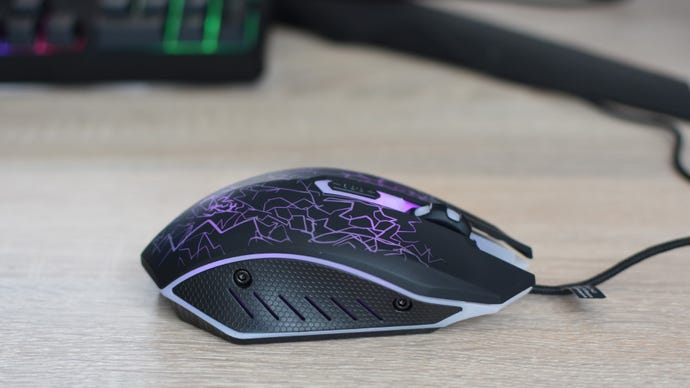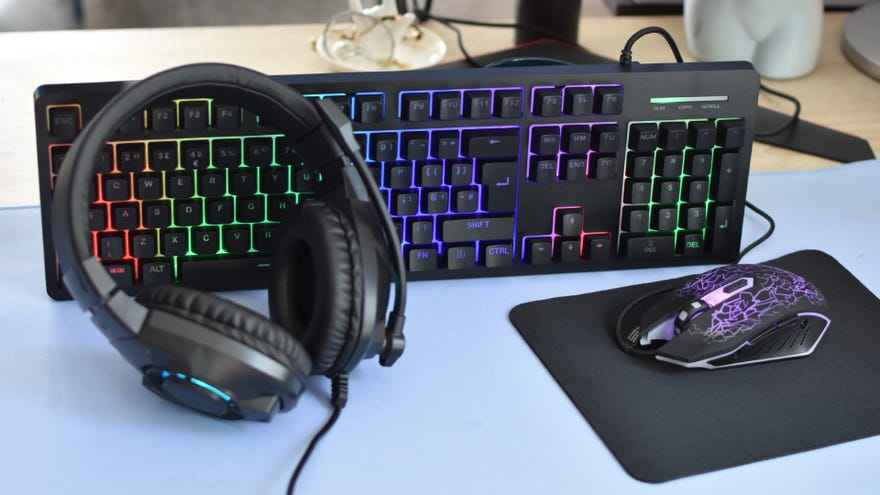I spent a week using supermarket own-brand gaming peripherals, and suggest that you don’t
This seemed like a good idea eight days ago
What if the company that sold your cheese also sold your PC gaming hardware? This is not the murmuring of some poor sod on a nineteen-hour Dota 2 binge who’s started thinking that the crumbs in his keyboard resemble a viable snack, but a bold new reality, one I recently found myself staring down during a trip to Asda. The supermarket chain – third biggest in the UK by turnover and purveyors of ill-fitting clothes and surprisingly good doughnuts alike – has added light-up gaming mice, keyboards, and headsets to its mountain of own-brand wares.
Asda being what it is (Americans, if you’re unfamiliar, think Walmart with less gun violence), it’s all dirt cheap as well. £17 for a full-size keyboard. £16 for an FPS mouse. Overwhelmed with curiosity, I ended up taking home a complete starter set (keeb, different mouse, headset, and mousemat) for £45, or about a third of the price of the Logitech G515 Lightspeed TKL that I’d shortly kick off my desk. Could this be a new frontier in affordable PC hardware, bringing tech to the masses in a way no specialist retailer ever could, or should supermarkets stick to cereal and meal deals? Surely the Asda Tech (real name) 4-in-1 Gaming Kit would have the answers.
Early impressions were pleasantly decent. The mousemat was only slightly more spacious than a postage stamp and the lightning storm decoration on the mouse looked like an infant had just scratched off the coating with the edge of a coin, but the latter also sported multiple thumb buttons and a tangle-resistant braided cable, while the keyboard had an almost refined simplicity to its design. Least impressive was the headset, the rattly plasticness of which stood out even in a box full of rattly plastic, though this too offered padded leatherette and an appealing lightness.

Worries began brewing, however, when I went to plug everything in. First off, the USB connectors on the mouse and keyboard were weirdly enormous, to the extent that I physically couldn’t fit them in adjacent ports on the rear I/O panel. The headset’s wiring solution, meanwhile, was a writhing mass of different plugs: separate 3.5mm mic and headphone jacks, pre-connected to a single 3.5mm combo jack, with yet another USB connector off to the side. This last one couldn’t actually carry audio, either – as far as I could tell, it existed solely to feed power to the thin lighting circles on the earcups.
Still, nothing exploded, melted, or otherwise disintegrated on first contact with a working PC, so that’s good going for peripherals that average out at £11.25 apiece. And once they went on their first real gaming duty, the keyboard in particular proved perfectly adequate. It’s a membrane/rubber dome deal, as you’d expect, but the keys were closer to bouncy than spongy, with a decisive pressing action that made mishits about as rare as on that fully mechanical G515.
The mouse, though? If Asda still did a Smart Price range, this would have been a Smart Price mouse. While not noticeably inaccurate, as a pointer of crosshairs or a selector of units, I only got a few rounds of Apex Legends in before fatigue crept in – likely a result of the relatively flat, loping left- and right-click buttons, which in my palm grip left the finger joints unsupported. As if sculpted by someone who’d seen a JPG of an ergonomic gaming mouse, but had never actually pushed one around.

Other than a satisfyingly solid click mechanism, it also had the structural integrity of the Mini Cheddars three aisles from where I found it. The thumb buttons felt like they’d either snap or ping off if I pressed too hard, and the matte-finish plastic developed smudgy, greasy marks within days. Also, the DPI switch revealed itself as a big fat fibber: despite the plus and minus symbols, it’s a single button rather than a rocker, and only cycles through the sensitivity options in ascending order. You lie, DPI switch. For shame.
The headset, despite the ropey build quality of its own, did at least reveal some bright spots. The microphone, somehow, was excellent – its voice recording as crisp and clean as my £89 Rode desktop mic, and an instantly audible improvement over the £140 HyperX Cloud Alpha Wireless that I usually wrap around the ol’ cueball. And while it hasn’t been as comfortable, I had no qualms at all with wearing the Asda set for a couple of hours at a time.
Just one problem: it sounded pants. Utter, frayed, unwashed Y-fronts. Beyond a passable amount of mid-frequency punch, the bass was weak and the trebles were muted, leaving what should have been big, impactful audioblasts – explosions, sword slashes, and the like – sounding damp and vague. The stereo effect, meanwhile, was inexplicable: noises made by something in the middle of the screen could sound as if they were coming from behind, and if that character/object/ordnance was just slightly to the left or right, the sound would swing way out to the edges. If you’re the competitive sort that likes to listen for offscreen enemy footsteps, you’d have as much luck pinpointing their positions with a drinking glass held up to your monitor.
It won’t surprise anyone who’s used one of their self-service checkouts, but Asda Tech’s software utility wasn’t very good either. For one thing, it only let me customise the mouse – there were no rebinding or lighting controls for the keyboard – and even that wasn’t fully supported. The full, vaguely RGB-ish selection of colours and effects was only available for, presumably, that more Decepticon's shoe-looking mouse Asda sell separately. This section was greyed out for my bundle mouse, so the lighting colour options amounted to twelve, which is just a tad less than the 16.7 million shades afforded by RGB. I could fine-tune the sensitivity settings for that untrustworthy DPI switch, rebind individual buttons, or even add macros, though these were ultimately very basic settings for any peripheral software, most of which don’t have a UI design that looked like it was knocked together over lunchtime.
The mousemat is a mousemat.

I did make it to seven full days of using these peripherals, for work and play alike, so I can’t say that they don’t work. I know that’s faint praise bordering on the imperceptible, but before trying this kit, the only way I would’ve thought to get four gaming accessories for £45 would be to buy a pair of needle-proof gloves and fish them out of a skip.
But they’re not good. In fact they’re quite bad, with the exception of the keyboard, and even that only stands out by virtue of having nothing seriously wrong with it. Absolutely nothing here produces that spark of "Hey, this is quite neat actually" that genuinely plucky entry-level hardware, like Logitech’s G203 mouse or the SteelSeries Apex 3 keyboard, can ignite within moments. You’re under no obligation to spend your hard-earned cash on the sparkliest luxury kit possible, obviously, but when you’re going to have your hands on a mouse or your ears in a headset day in, day out, they need more going for them than just thumb buttons and an oddly effective mic.
And yet, the problem with supermarket-brand peripherals does seem limited to the execution, not the concept. If we believe games are for everyone, then by extension we must also believe in the gear for playing games must be accessible and affordable as well. That means cheap and cheerful hardware, easily available, and what’s easier than grabbing a new headset while you’re topping up the milk? I’d be perfectly happy if Asda (or Tesco or Sainsbury’s or whoever) simply redirected some of their grocery-flogging money into finding more quality-minded suppliers, because there’s nothing clearly wrong with the idea of own-brand peripherals. They just, uh, shouldn’t be these ones.

